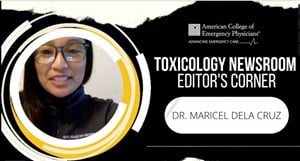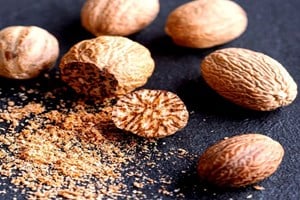
Dancing Bunnies: Treating a Young Child's Medication-Induced Hallucinations
The Case
A four-year old girl is brought in to the pediatric emergency room at 0400 after having what her parents described as a “night terror”. The parents were awoken from sleep at the sound of their little girl screaming. When they entered her room, they found her on the floor, in front of what appeared to be pink-colored vomit, which oddly smelled like bubblegum. She was “acting bizarrely” and interacting with invisible bunny rabbits, prompting the parents to call 9-1-1. While waiting for the ambulance to arrive, the parents noted that there was a partially empty bottle of Children’s Benadryl tipped over in the upstairs bathroom sink. On arrival to the ED, she was tachycardic to 165, tachypnic to 128, and mildly hypertensive with a systolic BP of 126. During the initial assessment, she was mildly agitated, picking at the air and speaking to the bunnies she saw hopping around her room. She had horizontal nystagmus, mydriasis, and was incontinent to urine. Her EKG showed a sinus tachycardia at a rate of 150 with the following intervals: PR 96, QRS 64, QTc 423.
Diphenhydramine
Diphenhydramine, a tertiary amine with a polar ethanolamine subgroup that allows for transport across the blood brain barrier, is somewhat of a dirty drug. It has wide-ranging effects on central and peripheral H1 receptors, sodium-channels, serotonin receptors, but most interestingly on central and peripheral muscarinic acetylcholine receptors. It’s here where it acts as a competitive antagonist causing all of the “mad as a hatter, blind as a bat, dry as a bone” symptoms of the anticholinergic toxidromes we’ve come to learn and love.
Acute overdoses typically occur at 3-5 times the normal dose with the lethal range somewhere between 20-40mg/kg. These serious-to-massive overdoses can be complicated by seizures, rhabdomyolysis, hyperthermia, renal failure, pancreatitis, QRS widening leading to fatal arrhythmias, and myocardial depression. Treatment includes supportive measures (ie, airway management, IV fluids, cooling measures), sodium bicarbonate for QRS widening, and physostigmine for central and peripheral antimuscarinic toxicity, especially refractory tachycardia and hallucinations.
Physostigmine
Physostigmine is a naturally occurring carbamate ester with a tertiary amine group (which allows for CNS penetration in contrast to neostigmine, a quaternary amine). This cholinergic drug is derived from Physostigma venenosum, aka the Calabar Bean, and dates back to it’s use by the Efik people of modern-day Nigeria. It was used as a truth-serum of sorts. Those suspected of crimes were given a cocktail consisting of ground Calabar bean to drink. It was believed that those telling the truth would be saved by a higher power, and those lying would die instantly. One theory as to how this could have actually worked sounds something like this: those that were innocent had the confidence to drink the cocktail all at once, became acutely ill, and vomited up the poison, while the guilty would slowly consume the drink, allowing for systemic absorption and full toxic effect.
Modern day use as a antidote to anticholinergic toxicity has been hampered by a cultural reluctance dating back to a single paper published in 1980, where two patients, who each had prolonged QRSs prior to treatment, became asystolic after receiving physostigmine for tricyclic antidepressant overdose. Since then, there have been multiple large-scale studies demonstrating the safety of physostigmine for use in patients with a normal QRS. A 2010 study even demonstrated safety in patients with a normal QRS who demonstrated antimuscarinic toxicity from TCA overdose. Another study not only demonstrated its safety, but also showed that when compared to benzodiazepines, patients treated with physostigmine had more complete reversal of agitation and delirium, and had a shorter median time to recovery, with similar rates of adverse events.
Administration Details
For symptoms of antimuscarinic toxicity, most notably delirium, agitation, hallucinations, and refractory tachycardia, and with those with a QRS <100ms, R in aVR <3mm, R/S in aVR <0.7mm (ie, no “terminal” R wave), physostigmine can be given to adults at 0.5-2mg over a slow (roughly 10 minute) infusion. For our pediatric patients, the dose is 0.02 mg/kg, again over a slow, 10-minute infusion. It has a fast onset of about 5 minutes with a peak at 15 minutes and duration of 1-3 hours. Dosing can be repeated every 10-30 minutes; a 2010 paper demonstrated that those receiving repeat doses had no difference in hospital stay, or time to discharge. Most importantly, this paper showed that if a patient responded well to an initial dose and remained asymptomatic 6.5 hours later, they were highly unlikely to require any repeat dosing. While administering, be aware that central and peripheral cholinergic toxicity (glandular secretions, dizziness, ataxia, seizures, coma) is a possible adverse reaction, and it’s a good idea to have atropine available at the bedside (initially dosed at half of your physostigmine dose, but titrated to reverse bronchial secretions).
Case Resolution
Our 4-year-old patient initially received a total of 3mg of Lorazepam as well 1mg of Diazepam prior to being admitted to the pediatric intensive care unit. In the early afternoon, when the toxicology team evaluated her, she remained tachycardic and continued to hallucinate. She was given 0.3mg (roughly 0.02mg/kg) of physostigmine. Within a half hour her heart rate normalized and she stopped seeing the pretty little bunnies dancing around her room. The next day she was downgraded to the floor and ultimately discharged home in excellent condition.
References
- Burns MJ, et al. ”A Comparison of Physostigmine and Benzodiazepines for the Treatment of Anticholinergic Poisoning.” Ann Emerg Med 1999;35(4):374-381.
- Hoffman RS, et al. “Goldfrank's Toxicologic Emergencies, 10th Edition” McGraw-Hill Education, 2015.
- Katzung BG, et al. ”Basic & Clinical Pharmacology, 12th Ed.” Mc Graw-Hill Education, 2012.
- Liebelt EL, et al. ”ECG Lead aVR Versus QRS Interval in Predicting Seizures and Arrhythmias in Acute Tricyclic Antidepressant Toxicity.”Ann Emerg Med. 1995;26(2):195-201.
- Olsen KR, et al. ”Poisoning & Drug Overdose, 6th ed.” Mc Graw-Hill, 2012.
- Padilla RB, and Pollack ML. Letter. “The Use of Physostigmine in Diphenhydramine Overdose” Am J Emerg Med. 2002;20(6):569.
- Pentel P, et al.” Asystole Complicating Physostigmine Treatment of Tricyclic Antidepressant Overdose.” Ann Emerg Med. 1980;9(11):588-590.
- Proudfoot A. “The early toxicology of physostigmine: a tale of beans, great men and egos.” Toxicol Rev. 2006;25(2):99-138.
- Rosenbaun C, and Bird SB. “Timing and Frequency of Physostigmine Redosing for Antimuscarinic Toxicity” J Med Tocicol 2010;6:386-392.
- Triggle DJ, et al. “The Pharmacology of Physostigmine” CNS Drug Reviews 1998;4(2):87-136
Andrew Dowd, MD
University of Massachusetts, Emergency Medicine Residency



